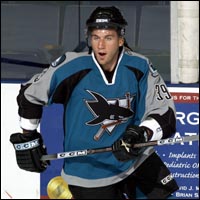by Bill Ballou || AHL On The Beat Archive
 Perspective is everything, when it comes to time, anyway.
Perspective is everything, when it comes to time, anyway.
If you’ve got a one-goal lead and are trying to kill a penalty in the last minute of the third period, 30 seconds is forever. If you’re in an airplane that’s about to hit the side of a mountain in British Columbia, and figure 30 seconds is about as long as you have to live, they go by fast.
That’s what Glenn Olson, a winger on the Sharks’ inaugural team here last year, found out on July 14. He and two friends were headed to a concert when, near noontime, the Cessna they were flying in crashed not far from Olson’s hometown of Port McNeill on northern Vancouver Island.
“We knew, or at least had a pretty good idea,” Olson said by phone last week, “for about 30 seconds before we crashed, that we were going down. I pretty much thought I was gonna die.”
The pilot did die. Olson and his other friend survived, but suffered agonizing injuries. Olson described his like this:
“I broke my right shoulder blade and all the ribs down my back on the right side. My right lung was punctured and I broke both collarbones. There was some internal damage to my legs, lots of bleeding, but nothing broken. Right now, my knees are pretty much the main problem, trying to rehab them.”
The Vancouver Sun, in a story written by Kelly Sinoski, reported on the crash in its July 15 edition:
— As Jeff Warden trudged through the dense nettles and the thick underbrush near Port McNeill (on July 14), he warned his young partner not to expect any survivors from the twisted plane wreck nearby. So when he called out, trying to locate the crash site, he was stunned to hear a response. It came from one of the plane’s passengers, Glenn Olson.
“Usually you hear people screaming or calling out in pain,” said Warden, a warrant officer with the Canadian Forces 442 Squadron in Comox. “I couldn’t even see the crash and this guy responded, ‘Yeah, we’re over here.’ The adrenaline started pumping. I wasn’t expecting survivors.”
After the crash report came through on his pager, Warden flew to the site on a Cormorant helicopter at about 2:30 p.m. He and his partner, carrying a litter and medical supplies, struggled for 10 minutes “hacking and slashing” through dense, uneven terrain full of nettles and deadfall until they found the crash site near Mt. Kinman, at the south end of Nimpkish Lake.
During the hike in, Warden warned his partner, who was facing his first fatal plane crash, to be prepared for deaths. “[The plane] was pretty twisted up,” he said. “Looking at it from the air, it didn’t look good. It’s amazing the two guys survived.”
Exhausted when they arrived, the two rescuers found the pilot, 34, dead at the scene. A 22-year-old passenger who was semi-conscious was lying across Olson, who … was trapped in his seat. The 22-year-old was extricated, hoisted up into the chopper and taken to Port Hardy, then transferred to Port McNeill. Warden’s partner went with the helicopter, while Warden remained behind to deal with the 220-pound, six-foot, four-inch Olson.
“There was a ton of wreckage on top of him; seats, luggage and electronics,” Warden said. “It took me 40 minutes to an hour to get him out of there.”
Warden said the two men were found in a part of the plane that was fairly intact despite the crash. The plane appeared to have nose-dived into the ground, and part of its tail was broken off. If the two had been in any other section of the plane, Warden said, their chances of survival would have been slim. —
Even though he was conscious after the crash, Olson wasn’t sure that he would survive the ordeal. He did not know if the plane’s emergency beacon had been ruined in the wreck and didn’t find out it was working until he heard helicopters overhead. Most of the time, his rescuers said, the beacons are so badly damaged they don’t work.
“When I heard them calling,” Olson said, “that was the best thing I’ve ever heard.”
Olson knew the pilot had died in the crash. “My other friend was unconscious,” he said, “and he was making some really crazy sounds. He was totally out cold and he was in a coma for two weeks. He’s still having problems now.
“I was pinned in there and couldn’t move, and their main concern was getting my buddy out of there first. That took maybe two hours. One guy stayed with me the whole time and gave me a shot of something, probably morphine, and that killed a little of the pain.
“I couldn’t see my legs, and when my one leg, when I finally saw it, I thought there’d be bones sticking all out of it. Really, from the pain, I thought it was broken right in half.”
Olson spent eight days in a hospital in Comox before being sent home.
The Sharks did not renew Olson’s contract after last year, his third as a pro. Remarkably, Olson fully intends to resume his career in professional hockey, hopefully as soon as next season. He has yet to be cleared to skate again, but is in the process of moving to Victoria to start a serious rehab program designed to get him back on the ice.
“Oh, they say everything should heal up 100 percent,” he said. “It’ll take time to build up the muscle again, but with time, I should be back on skates for next year. The toughest part of this is watching the highlights on TV and not being able to play. I’ve been on skates since I was three years old, and I haven’t even touched my hockey gear since the end of last season.”
Olson’s hockey friends started calling the hospital as soon as they found out about the crash, but for a while, he couldn’t take any calls. Which was exactly the opposite of what he wanted — he couldn’t wait to talk with his teammates.
Olson has not been back in an airplane since that July afternoon, but will have to, and sooner not later. His girlfriend, whom he met while playing in Worcester last year, lives in Dracut. Olson wants to come back and visit her, and his old teammates, right after the first of the new year.
“I’m still working on dealing with it,” he said, “but I’m planning to come out to Worcester in January. I can’t wait to get out there, but it’ll be weird going into the rink, and not playing.”
Reflecting on his ordeal, Olson said the crash was, “Not mechanical failure, just pilot error, picking the wrong place to go. There’s a lot of mountains around, and those little planes can’t climb.”
And he also has a sense that something more than pure luck was at work in his survival.
“I totally believe,” Olson said, “that someone was looking out for me. Not many people survive something like that. I definitely think there was some kind of higher power watching over me.”
Thanks to that higher power, he should be in Worcester in a matter of weeks, which doesn’t seem that long from now, except when compared to the 30 seconds he figured he had to live back in July.
Bill Ballou covers the Worcester Sharks and the AHL for the Telegram & Gazette





































